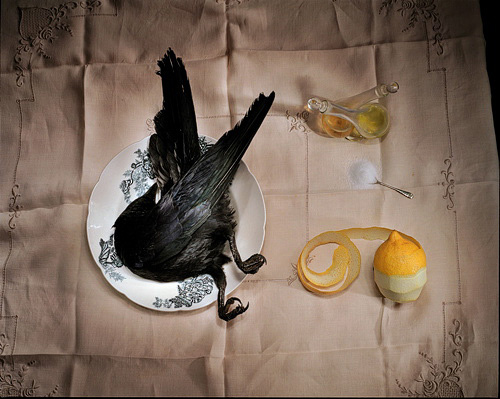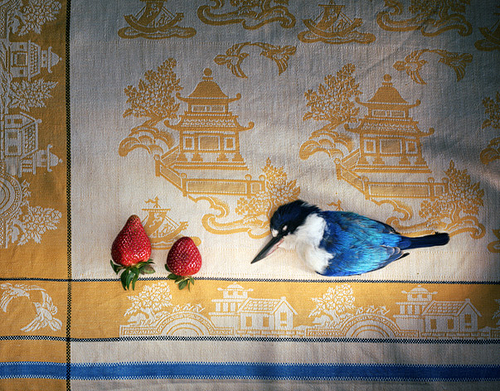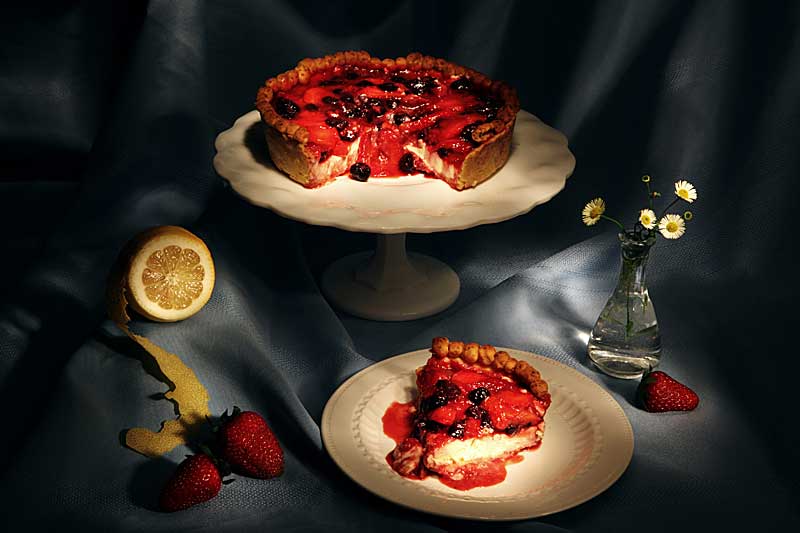In her beautifully composed photographs, Marian Drew includes the lifeless bodies of Australian fauna collected from the side of the road. The photographs represent a meeting of Europe and Australia through the insertion of wallabies, kangaroos, and possums into the still life tradition. The images assume a painterly tone achieved by long exposures and careful application of light via torch. This process allows Drew to highlight important elements in the composition as well as experiment with shadow as a form.

Marian Drew was directly influenced by the traditional still life paintings she studied while living in Germany. Ranked the lowest in the hierarchy of genres created in the 17th century, still lifes were considered to be merely a record of inanimate objects. The Dutch depicted opulent banquets with a seemingly endless bounty spilling over the edges of tables while the French presented an ordered and contained tableaux of goods. The fare was delivered to the viewer to be visually consumed and became a dialogue between a prosperous society and their material possessions. The still life genre featuring small game and poultry acted as a signifier of wealth. In Germany in the 15th century, hunting rights were only granted to the aristocracy. The still lifes demonstrated not only their control over nature by commanded their authoritative stature in society. This theme is continued by Drew who examines the dominating relationship between the urban landscape and it’s natural fauna. Life is juxtaposed against death and contemporary cultural identity is explored through the traditions of the still life.

While driving down a dusty road in the short documentary Australiana, Drew states that in Australia, citizens are not encouraged to pick up roadkill because it acts as food for other native animals. With this in mind, her compositions take on a whole new meaning. What we consider to be inedible waste becomes a meal for another. Although I cannot appreciate four and twenty blackbirds baked in a pie, the blushing strawberries and the sunny lemon would make a tempting dessert to set before a king.
The photograph of the Berry & Lemon pie was created using the same methods developed by Marian Drew.

Berry & Lemon Cheese Pie with a Lemon Butter Crust
1 punnet fresh strawberries
1/3 cup honey
1 lemon
3 TB sugar
1 pkg cream cheese
1 tsp vanilla
1 punnet fresh berries (blueberries or blackberries)
Prepare the Lemon Butter Crust (recipe below) and have ready and chilled. In a medium bowl, mix the cream cheese, vanilla, sugar, and tsp lemon zest. Cream with an electric mixer until light and fluffy and the sugar has dissolved. Spread onto the bottom of the baked pie crust.
Divide the strawberries and cut half into quarters and place in a new bowl. With a hand blender puree the strawberries and mix in the juice from half of the lemon and the honey (alternatively you could mash the strawberries with the back of a fork). Pour the mixture into a small sauce pan and bring to a boil. Meanwhile slice the remaining strawberries. Once the strawberry mixture is boiling begin to stir continuously to keep from burning. Cook for two minutes and take off the heat. Add the remaining strawberries and blueberries, mix, and pour over the lemon cheese layer in the pie.
Chill the pie in the refrigerator until the berries have set an a slice will hold it’s shape (about 3 hours). Serve cold.
Lemon Butter Crust
1 1/4 cups plain flour
1/2 cup unsalted butter (room temperature)
1 tsp lemon zest
1 tsp sugar
1 tsp salt
1 TB water
Place the flour, butter, lemon zest, sugar, and salt in a large bowl. Begin rubbing the butter into the flour working it until the mixture resembles wet sand and clumps together. Add 1 TB of water and mix turning out onto a floured surface and kneading slightly. Form into a round disk and chill in the refrigerator for 1 hour.
Work the dough into a 1 cm round on a floured surface with a floured rolling pin. Fit into a buttered pie pan. If the pastry breaks up you can fit it back together by pressing it into the pie tin. Ensure there is an even layer of pastry within the tin. To create the decorative edge roll the remaining pastry into small balls and press around the edge of the tin. Once assembled in the pie tin, place the pastry in the freezer.
Heat the oven to 350°F/180°C. Remove the tin from the freezer and place a sheet of parchment paper over it and pour in dried beans or rice to weight the pastry. This will keep the base from rising. Slide into the oven for 20 minutes. Remove the baking weights and prick the base of the crust with a fork to release steam. Return the crust into the oven for an additional 10 minutes until golden. Add non-cooked filling.

19 comments
shaz says:
Dec 3, 2009
Awesome photo Megan! I was a bit worried when I started reading about the roadkill there for a bit, luckily it was only fruit you ended up baking!
Heavenly Housewife says:
Dec 3, 2009
Oh my! I cant say i am a fan of the lifeless bodies, but the cheese pie looks awesome LOL.
Mimi says:
Dec 3, 2009
Hello Meganbr /I found your blog via Megan at Imperrfections. I really enjoyed my visit and will be back again.br /Mimi
Rosa's Yummy Yums says:
Dec 3, 2009
A gorgeous sounding pie! I love those pictures!br /br /Cheers,br /br /Rosa
Hungry Dog says:
Dec 4, 2009
I love this post–yet another artist I knew nothing about. I actually really love the paintings of hers that you posted. And your photograph of the wonderful pie is also stunning.
lostpastremembered says:
Dec 4, 2009
Great picture.. it was like a magic show!br /Thanks!
Lauren says:
Dec 4, 2009
Fascinating photos. I can#39;t tell whether I love them or hate them, and that tension is captivating! Very cool, I#39;ll definitely be looking at her work. Not to mention this pie, it looks heavenly.
Sophie says:
Dec 5, 2009
I am not a fan for the lifeless bodies,..no way!br /br /But your pie with the apart crust looks absolutely divine,….br /br /MMMMMMMMMMMMM,….
flintstone says:
Dec 6, 2009
Your berry pie looks delicious and your photography is great.
Karine says:
Dec 6, 2009
Your pie looks wonderful! Thanks for sharing :)
Julie says:
Dec 6, 2009
The bird in the first still life reminds me of the sculpture of a dead bird outside of the research lab at Wayne State University. Not surprisingly, animal rights advocates staged a protest there… I am glad you made a fruit pie from the other still life elements!
dessert girl says:
Dec 6, 2009
Honestly, when I first saw this post, I thought that I might have to write that I hated the Drew photos, but after reading the whole roadkill bit, I started to hate them less. :-) Not that I love them now, but I see what he#39;s saying and the colors of the birds are gorgeous. Your pic, on the other hand, it right up my alley! ~Erin
Mae says:
Dec 8, 2009
Yes, probably better not to bake any blackbirds into pies, no matter how much the nursery rhymes may want you to.br /br /The berries and lemon, however, don#39;t put up much of a fight and lordy, I#39;m glad they don#39;t!br /br /I#39;m a big fan of your site and work!br /br /- Mae
Lael says:
Dec 11, 2009
Thanks so much for introducing me to Marian Drew. Her work is very intriguing. (I#39;m more appreciative of the still Kingfisher with a matching blue stripe of cloth below him than of the crow and its creepy feet, I think – though I like the color palette there as well.) As for your berry pie, it sounds like a delicious combination of ingredients, especially with all that lemony flavor. It would make a perfect for a late-spring dessert. Cheers!
liz {zested} says:
Dec 15, 2009
Stunning photo – your best one yet. Totally unique. quot;By torchquot; I assume that means flashlight? Or spotlight? Did you direct the light by hand during a super-long exposure? So cool.
Megan@Feasting on Art says:
Dec 15, 2009
Thanks Liz. A torch is a flashlight. I had the camera on the bulb setting in a completely black room and moved around lighting the objects with the flashlight during a 30-40 second exposure. It was a lot of fun!
nikki says:
Dec 15, 2009
Thanks for introducing the artwork of Marian Drew. I think I have to make a lemon cheese pie right now!
Isabelle says:
Dec 18, 2009
Your tart sounds divine! Thanks so much for introducing me to Marian Drew. Your photos are beautiful.
Lj Orlin says:
Jan 23, 2011
I only just got introduced to your wonderful blog today via Design Sponge. What an extraordinarily creative mind you have!
And I am so glad that Marian Drew has found a use for roadkill. Thought provoking!
Perhaps you heard of a little cookbook on sale at US truck stops a few years ago called “Roadkill Helper.”
Hilarious recipes that truckers could appreciate. However the makers of Hamburger Helper threatened a lawsuit and the “cookbooks” disappeared. Wish I had bought one at the time although they grossed me out.
Thanks for this interesting website. Keep up the good work.
[You also made me look up the word “punnet.”]
Could you continue to describe more about how you are taking you photos? Like how are you taking a special low light, slow exposure photo digitally?